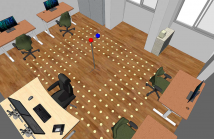
ICASSP 2022 - IEEE International Conference on Acoustics, Speech and Signal Processing is the world’s largest and most comprehensive technical conference focused on signal processing and its applications. The ICASSP 2022 conference will feature world-class presentations by internationally renowned speakers, cutting-edge session topics and provide a fantastic opportunity to network with like-minded professionals from around the world. Visit the website.

- Read more about SCORE DIFFICULTY ANALYSIS FOR PIANO PERFORMANCE EDUCATION BASED ON FINGERING
- Log in to post comments
In this paper, we introduce score difficulty classification as a subtask of music information retrieval (MIR), which may be used in music education technologies, for personalised curriculum generation, and score retrieval. We introduce a novel dataset for our task, Mikrokosmos-difficulty, containing 147 piano pieces in symbolic representation and the corresponding difficulty labels derived by its composer Béla Bartók and the publishers. As part of our methodology, we propose piano technique feature representations based on different piano fingering algorithms.
- Categories:
 39 Views
39 Views
- Read more about Improving Cross-lingual Speech Synthesis with Triplet Training Scheme
- Log in to post comments
Recent advances in cross-lingual text-to-speech (TTS) made it possible to synthesize speech in a language foreign to a monolingual speaker. However, there is still a large gap between the pronunciation of generated cross-lingual speech and that of native speakers in terms of naturalness and intelligibility. In this paper, a triplet training scheme is proposed to enhance the cross-lingual pronunciation by allowing previously unseen content and speaker combinations to be seen during training.
- Categories:
 19 Views
19 Views
- Read more about JOINT SOURCE LOCALIZATION AND ASSOCIATION THROUGH OVERCOMPLETE REPRESENTATION UNDER MULTIPATH PROPAGATION ENVIRONMENT
- Log in to post comments
- Categories:
 9 Views
9 Views
- Read more about VISION TRANSFORMER EQUIPPED WITH NEURAL RESIZER ON FACIAL EXPRESSION RECOGNITION TASK
- Log in to post comments
When it comes to wild conditions, Facial Expression Recognition is often challenged with low-quality data and imbalanced, ambiguous labels. This field has much benefited from CNN based approaches; however, CNN models have structural limitations to see the facial regions in distance. As a remedy, Transformer has been introduced to vision fields with a global receptive field but requires adjusting input spatial size to the pretrained models to enjoy its strong inductive bias at hands.
1683-1.pdf
- Categories:
 11 Views
11 Views
Emotion recognition in conversations (ERC) has attracted increasing interests in recent years, due to its wide range of applications, such as customer service analysis, health-care consultation, etc. One key challenge of ERC is that users' emotions would change due to the impact of others' emotions. That is, the emotions within the conversation can spread among the communication participants. However, the spread impact of emotions in a conversation is rarely addressed in existing researches.
- Categories:
 25 Views
25 Views
- Read more about L3DAS22 Challenge: Learning 3D Audio Sources in a Real Office Environment
- Log in to post comments
The L3DAS22 Challenge is aimed at encouraging the development of machine learning strategies for 3D speech enhancement and 3D sound localization and detection in office-like environments. This challenge improves and extends the tasks of the L3DAS21 edition1. We generated a new dataset, which maintains the same general characteristics of L3DAS21 datasets, but with an extended number of data points and adding constrains that improve the baseline model’s efficiency and overcome the major difficulties encountered by the participants of the previous challenge.
- Categories:
 11 Views
11 Views
- Read more about Applying Differential Privacy to Tensor Completion
- Log in to post comments
- Categories:
 11 Views
11 Views
- Read more about Applying Differential Privacy to Tensor Completion
- Log in to post comments
paper#1362.pdf
- Categories:
 13 Views
13 Views
- Read more about SEISMIC FAULT IDENTIFICATION USING GRAPH HIGH-FREQUENCY COMPONENTS AS INPUT TO GRAPH CONVOLUTIONAL NETWORK
- Log in to post comments
Many activities such as drilling and exploration in the oil and gas industries rely on identifying seismic faults. Using graph high-frequency components as inputs to a graph convolutional network, we propose a method for detecting faults in seismic data. In Graph Signal Processing (GSP), digital signal processing (DSP) concepts are mapped to define the processing techniques for signals on graphs. As a first step, we extract patches of the seismic data centered around the points of concern. Each patch is then represented in a graph domain, with the seismic amplitudes as the graph signals.
- Categories:
 14 Views
14 Views
- Read more about THE VICOMTECH AUDIO DEEPFAKE DETECTION SYSTEM BASED ON WAV2VEC2 FOR THE 2022 ADD CHALLENGE
- Log in to post comments
This paper describes our submitted systems to the 2022 ADD challenge withing the tracks 1 and 2. Our approach is based on the combination of a pre-trained wav2vec2 feature extractor and a downstream classifier to detect spoofed audio. This method exploits the contextualized speech representations at the different transformer layers to fully capture discriminative information. Furthermore, the classification model is adapted to the application scenario using different data augmentation techniques.
- Categories:
 66 Views
66 Views